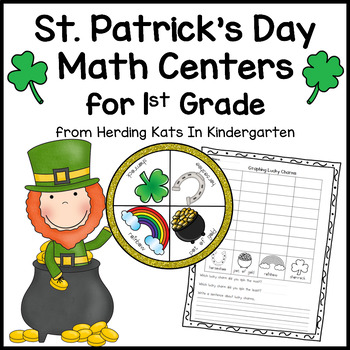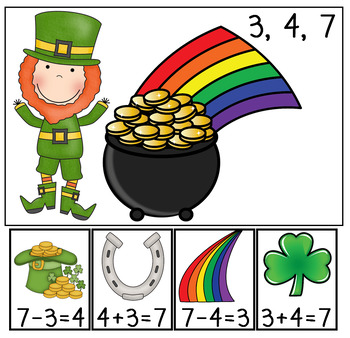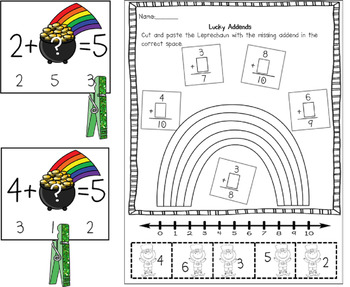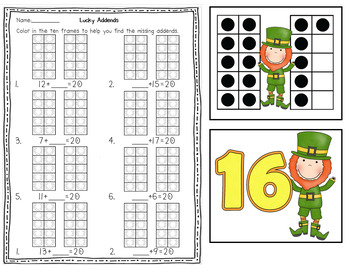St. Patrick's Day Activities for Math
- PDF
Description
Seven St. Patrick's Day activities and matching worksheets to help your students learn essential math skills while celebrating St. Patrick's Day in the classroom! Included are 7 activities suitable for small groups or independent math centers, covering the following skills: ten frames, missing addend addition, time to the hour and half hour, finding 10 more and 10 less than a number, data analysis and graphing, place value, addition & subtraction within 20, comparing numbers and fact families to use in the week leading up to St. Patrick's Day! Each activity has a recording sheet, so that your students are accountable in centers. These activities are Common Core aligned but can also go along with individual state standards.
Included:
Lucky Ten Frames activity – students can either play a memory style game
with the cards, or match them up and arrange them in numerical order in a
pocket chart. 1.NBT2
Missing Addend Worksheets. They are differentiated for sums to 10 and
to 20 so you can choose which ones you want your students to work on. 1.OA.8
Missing Addend Read and Write the Room activity - arrange the cards
you wish the students to work on (there are 8 for sums to 10 and 8 for sums to
20) and students solve the equations and write them on the recording sheet.
1.OA.8
Telling Time Read and Write the Room activity - arrange the cards you
wish the students to work on (there are 8 cards for time to the hour and 8
cards for time to the half hour). Students walk around the room finding the
cards and recording the matching digital time on their sheet. 1.MD.3
Missing Addend Clothespin activity - print the cards and place a small
sticker on the back of the card where the correct answer is. Students use the
number lines to figure out the missing addend and then place a clothespin on
the correct answer. They can check themselves by flipping the card over to see
if they are correct. 1.OA.8
More/Less worksheets – students use the 120 chart to help them find 10
more/10 less/1 more/1 less. 1.NBT.5
Lucky Spin and Graph activity – students spin and graph which Lucky
charm the spinner lands on. When one Lucky charm reaches the top of the graph
they stop spinning and answer questions about their graph. 1.MD.4
Lucky Graphing sheet - students practice graphing according to a tally mark
chart and answer questions about the graph. 1.MD.4
Place Value worksheets – students work with place value cubes to
represent numbers. 1.NBT.2
Lucky Roll & Cover Addition and Subtraction games – students roll 2
dice and add or subtract depending on their game board. 1.OA.6
Comparing Numbers worksheet – students cut and paste symbols to show the
relationship between sets of numbers. 1.NBT.3
Lucky Charms Fact Family activity – students choose a fact family Leprechaun mat and find the matching Lucky charms with the correct fact family equations. 1.OA.B.3
You Might Also Like:
• Lucky Leprechauns! St. Patrick's Day Roll & Graph Activity
• Lucky St. Patrick's Day Roll & Cover Addition & Subtraction Games!
• St. Patrick's Day Activities for Measurement
• St. Patrick's Day CVCE Words Game





